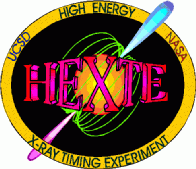

The High Energy X-ray Timing Experiment
The HEXTE was designed, fabricated and tested at UCSD's Center for Astrophysics & Space
Sciences (CASS), and
is one of three instruments which form NASA's Rossi X-ray Timing Explorer
mission (RXTE), named in honor
of the X-ray astronomy pioneer Dr. Bruno B.
Rossi. The RXTE was launched
into a 580 km orbit on 1995 December 30 by a Delta II expendable launch
vehicle. The HEXTE Principal Investigator is Dr. Richard Rothschild.
The HEXTE, a descendent of the UCSD/MIT A4 experiment on the
HEAO-1 consists of two clusters of 4 NaI/CsI
phoswich scintillation detectors, which are sensitive to X-rays from 15 to
250 keV. Together with the RXTE's other instruments (provided by MIT's Center for Space Research and
NASA's Laboratory for High Energy
Astrophysics), the HEXTE provides unprecedented timing information on
the nature of compact objects such as white dwarfs, neutron stars and black
hole candidates, both in our own Galaxy and in our neighbors the Small and
Large Magellanic Clouds. Using the HEXTE, astronomers are also measuring the
high energy spectra of many Active Galactic Nuclei for the first time, and
testing theories for the origin of the X-ray background.
The HEXTE instrument team at UCSD is located on the 4th floor of the new
Science and Engineering Research Facility (SERF) on the UCSD campus. Funding
is provided under NASA contract NAS5-30720. For further information, please
contact the HEXTE project secretary, Mrs. Shirley Roy, at (619) 534-2690.
Last updated 1996 May 30 by Philip Blanco
pblanco@ucsd.edu

